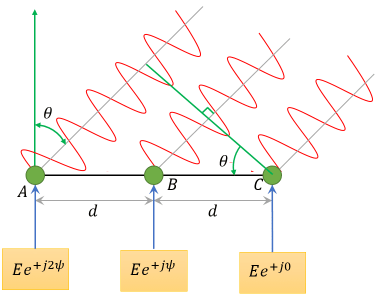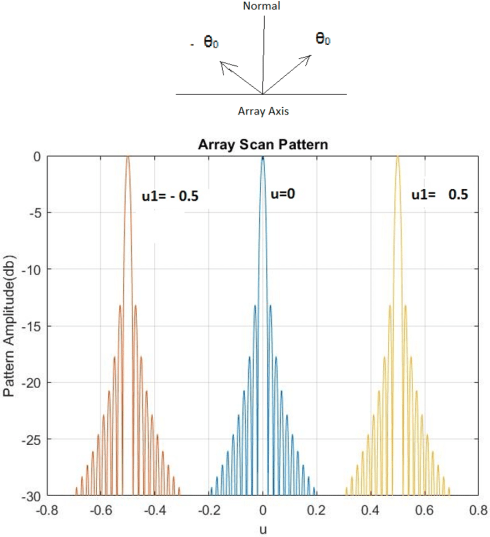Articles in this series
- Phased Array Antenna – an introduction
- Electronic Scanning Arrays (this article)
- Grating lobes in electronic scanning
- Array pattern multiplication
Electronic scanning arrays
This is considered to be the best feature of a phased array antenna. To be able to scan in a given space, without having to rotate the antenna is called inertia less scanning and serves many advantages, especially in field operations.
To illustrate the principle, let us take a simple three element linear array arranged with the following phase relationship due to its beam tilted towards an angle θ to receive signal, as shown below:

The path difference between adjacent elements is= d sin (θ) and it progressively increases from right to left. So BB’= d sin (θ) whereas CC’= 2d sin (θ). If we assume that an incoming field with planar wavefront having equal amplitude and equiphase is across CC’, one can visualize the extra path that has to be traveled to reach element A and B, in comparison to the element C. Translating this into phase shift, we have a phase delay= φB = (2π/λ) d sin (θ) at element B, and φA= (2π/λ)(2d)sin(θ) at element A, all reckoned with element C as the point of phase reference. So in the final tally, the field captured along the three-element array comes out to be EResultant = E (1+e-jφ+ e-j2φ), where φ = (2π/λ) d sin(θ) and E is the field value of the incoming equiphase front. The magnitude of the resultant field can be simplified to E(1+2 cos (φ)). It is clear that the field captured by all elements adds up to 3E only when cos (φ) equals zero, which is the case when the antenna is looking at its perpendicular direction, called the broadside. But this is the initial position without scanning. The expression further shows that array gain falls as the angle of scan increases, theoretically falling to E at φ=± π/2. (A simple vector diagram will reveal that at this state, the field received by element A will oppose that of element C). This position also coincides with the limits of scan in the visible region corresponding to a scan limit of θ= ± 90°, for (d/λ) =1/2.
The above example forms the basis for exploring the method of electronic scanning, further.
If we need to receive a signal from an angle inclined from the bore-sight (θ=0°), then there is an inevitable phase shift (delay) to signal reaching the different elements. Hence the uniform phase front along the linear antenna array is no longer along its axis but lifted (refer line CC’) at an angle equal to the angle of scan, (θ in the above example). If we wish to bring back this tilted equiphase plane along the axis of the array, it is obvious each element should now have a phase shift of its own to counter the phase delay they suffered. The required phase shift would be equal in magnitude but in opposite direction.
Let the array be now modified with each element provided with a phase shifter individually. A phase shift + ψ is introduced in a progressive manner from left to right to compensate the phase delays produced earlier by the incoming signal.

The modified array equation gives the resultant field = E (1+e-j(φ-ψ) + e-j2(φ-ψ))
Making (φ-ψ) = δ, the above reduces to Ee-j δ(e+jδ + 1 + e-jδ) = E e-j δ [1+2 cos (δ)], which attains maximum at δ =0, making φ=ψ. Remember that φ=(2π/λ) d sin (θ).
Suppose we want the beam to position at θ=30°, then ψ = (2π/λ) d sin (30°). If we need to scan to a direction θ=-30°, then ψ =- (2π/λ) d sin(30°), will be a lagging phase shift.
What essentially resulted was that the equiphase plane inclined at θ was brought back to the array surface by phase weighting (ψ) of the element as arranged in Figure 2. The phase weight is dependent on the angle chosen for the scan, once the designer has already selected the spacing among elements (d/λ). This phase weight will then have to continually track its value in sync with the position of the scan angle ‘θ ‘.
A general equation can now be attempted to describe the pattern of a linear array antenna with N elements:

A simulation run with an array antenna is shown in Figure 1. A linear array of 100 elements was chosen (N=100), with the inter-distance between elements d=λ/2. The desired angle of scan was u1=sin(θ0) This was set for three values: u=0 (broadside), and at u1=± 0.5 (angle of ±30°).

It is true that the gain of the scanned patterns becomes a function of the scanned angle [Gθ = G cos(θ)]; this fact is not visible in this plot as each pattern is normalized with respect to its own peak.
Continue reading about the discussion on grating lobes…
For further reading
Benjamin et. al., “Phased array technologies”, Proceedings of the IEEE, Vol. 104, No. 3, March 201
Rate this post:


Sir, Which is a good book to build intuition and mathematical rigor on array signal processing?